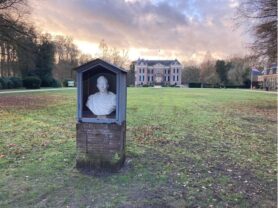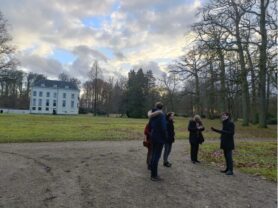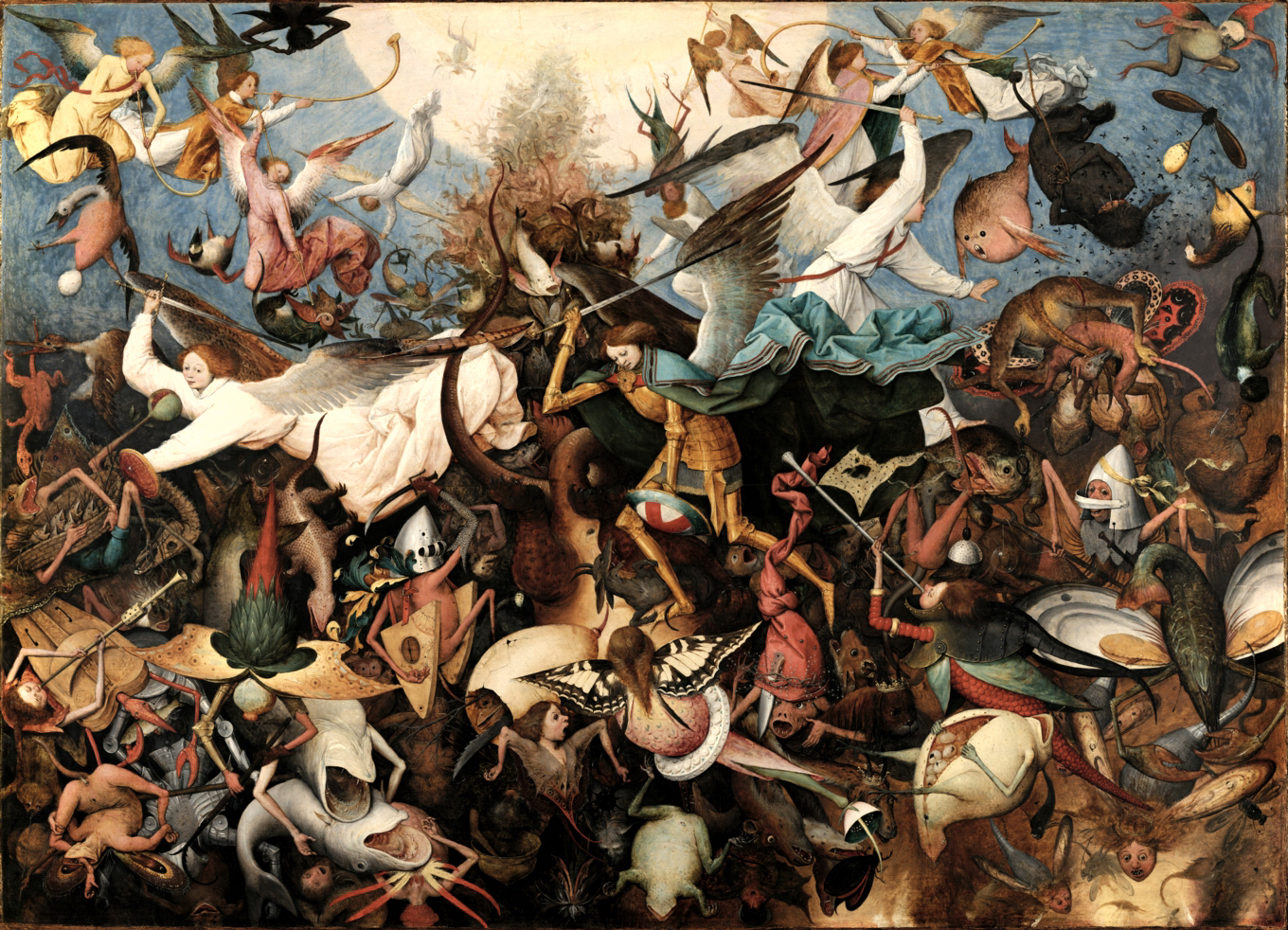Blog
Een honourswaardig bezoek aan Huis Doorn
Door Robert Snitselaar
Op 31 januari 2023, een kille, regenachtige dag, betrad een delegatie van studenten van het Humanities Honourse Programme van de Universiteit Utrecht het terrein van Huis Doorn, de laatste rustplaats van de laatste Duitse keizer, Wilhelm II van Hohenzollern. In dit landhuis sleet hij de laatste 21 jaar van zijn leven. Houthakkend, brieven schrijvend en hoop koesterend dat hij ooit onder luid gejuich van de Duitse bevolking naar zijn vaderland zou kunnen terug keren om de keizerstroon wederom te kunnen bestijgen. Helaas voor de keizer liep het allemaal anders.
Onze rondleiding werd gegeven door een enthousiaste gids die, aangevuld door honourscoryfee Frans Willem Lantink, ons maar wat graag wilde vertellen over de geschiedenis van het landgoed en de tijd van Wilhelms verblijf. Zo werden wij terug de tijd in gezogen en hebben wij mogen aanschouwen waar de ooit machtigste en belangrijkste man van Duitsland zijn avondeten at, zijn sigaren rookte en zijn brieven schreef. Hoewel het Huis is aangekleed met schilderijen van heroïsche veldslagen en portretten van machtige staatsmannen die de geschiedenis en Wilhelms eigen stamboom rijk is geweest, verhult het pracht en praal het een pijnlijke werkelijkheid. Huis Doorn is voor ons, gewone stervelingen, misschien een grote woongelegenheid, maar zoals de gravin van Keller zei: ‘Majesteiten zijn nu eenmaal geen gewone stervelingen!’ Voor de keizer, die gewend was aan residenties zoals het Marmerpaleis in Potsdam en het Berliner Stadtsschloss, moet Huis Doorn hebben aangevoeld als een bungalow. Toch wilde de keizer duidelijk niet beginnen aan een nieuwe inboedel. Zo zijn de vele spullen die zijn oude paleizen aankleding gaven in maar liefst 59 treinwagons naar Nederland gebracht. Je kunt je voorstellen dat de inboedel van enorme paleizen het kleine Huis Doorn aardig opvult.
Na de rondleiding hebben we nog een bezoek gebracht aan de tijdelijke tentoonstelling ‘Leven in een stroomversnelling’ over Nederland in het interbellum die de technische en culturele veranderingen in de jaren ’20 onder de aandacht brengt. Ook hebben we het aansluitende Paviljoen Eerste Wereldoorlog bezocht waar we de permanente tentoonstelling ‘Tusschen twee vuren’, over wat de Eerste Wereldoorlog voor Nederland te betekenen had, mogen aanschouwen. Hier hebben we veel geleerd over de neutraliteitspolitiek van de overheid, de censuur van kranten zoals de toen nog anti-Duitse Telegraaf en de betreurenswaardige staat van het Nederlandse leger, samengevat in een foto met het onderschrift: ‘zeven soldaten, waarvan vijf met geweer’.
Na onze kennis weer te hebben opgefrist wat betreft de Eerste Wereldoorlog, hebben we nog een wandeling gemaakt door de tuin. Hier hebben we naast het poortgebouw, de plek waar Wilhelm zijn hobby houthakken uitoefende en de rozentuin van Augusta Victoria ook het mausoleum van de keizer bezichtigd. Waar we naar binnen spiekend de laatste rustplaats van de laatste Duitse keizer konden aanschouwen. Wachtend tot zijn botten naar zijn vaderland terug mogen keren, wanneer er in Duitsland weer een monarch met de scepter zwaait.


English
On 31 January 2023, a chilly, rainy day, a delegation of students from Utrecht University’s Humanities Honours Programme entered the grounds of Huis Doorn, the final resting place of the last German emperor, Wilhelm II of Hohenzollern. In this country house, he spent the last 21 years of his life. Lumbering, writing letters and cherishing hopes that one day he would be able to return to his homeland to the cheers of the German people and ascend the imperial throne once more. Unfortunately for the emperor, it all turned out differently.
Our tour was given by an enthusiastic guide who, complemented by honours scholar Frans Willem Lantink, was only too happy to tell us about the history of the estate and the time of Wilhelm’s stay. Thus, we were sucked back in time and witnessed where Germany’s once most powerful and important man ate his dinner, smoked his cigars and wrote his letters. Although the House is decorated with paintings of heroic battles and portraits of powerful statesmen that history and Wilhelm’s own family tree have been rich in, the pomp and circumstance mask a painful reality. To us mere mortals, Huis Doorn may be a grand residence, but as the Countess of Keller said, ‘Majesties are not mere mortals!’ To the emperor, who was used to residences like the Marble Palace in Potsdam and the Berliner Stadtsschloss, Huis Doorn must have felt like a bungalow. Yet the emperor clearly did not want to start a new household. Thus, the many items that decorated his old palaces were brought to the Netherlands in no fewer than 59 railway carriages. You can imagine the contents of huge palaces filling up the small Doorn House quite nicely.
After the guided tour, we visited the temporary exhibition ‘Leven in een stroomversnelling’ (Living in flux) about the Netherlands in the interwar period that highlights the technical and cultural changes in the 1920s. We also visited the connecting First World War Pavilion, where we got to see the permanent exhibition ‘Tusschen twee vuren’, about what the First World War meant for the Netherlands. Here we learned a lot about the government’s neutrality policy, the censorship of newspapers such as the then anti-German Telegraaf and the deplorable state of the Dutch army, summed up in a photo with the caption: ‘seven soldiers, five of them with rifles’.
Having refreshed our knowledge again regarding World War I, we took another walk through the garden. Here, besides the gatehouse, the place where Wilhelm practised his hobby of woodcutting and the rose garden of Augusta Victoria, we also visited the emperor’s mausoleum, where we peered inside to behold the last resting place of the last German emperor. Waiting for his bones to be allowed to return to his homeland when a monarch once again waves the sceptre in Germany.

